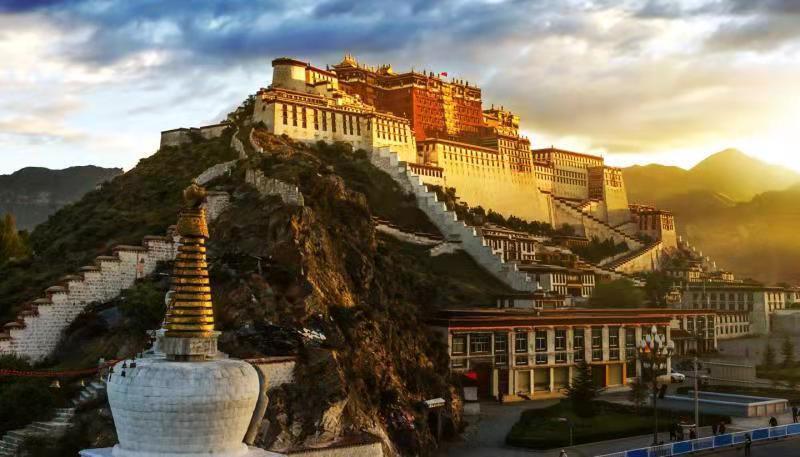On May 23, 1951, the "17-Article Agreement" signed by the Central People's Government of China and the local government of Tibet proclaimed the peaceful liberation of Tibet. This year marks the 70th anniversary of the peaceful liberation of Tibet. These 70 years of hard work have brought about comprehensive progress in the area’s social system, people’s lives, cultural construction, freedom of religious belief, and ecological and environmental protection. These 70 years have also witnessed Tibet’s stepping into the light from the long night.

Democratic reform
Before liberation, old Tibet practiced theocratic feudal serfdom. Religious power overwhelmed political power, and political power protected religious privileges. The two joined forces to defend the interests of three major stakeholders: officials, nobles, and high-ranking lamas in monasteries. At that time, people were divided into three levels according to descent and status, and each level was divided into three levels. The value of life corresponds to the difference in class and hierarchy. The body of the highest person in the upper class is "comparable to gold," while the life of the lower class in the lower class is "comparable to a straw rope." These three stakeholders are undoubtedly the top class people. Although it only accounts for less than 5% of the population in Tibet, it has all the arable land, pastures, forests, wasteland and mountains, and most of the livestock in Tibet, and controls almost all of Tibet's wealth. The remaining 95% of serfs and slaves did not have their own means of production and freedom. They suffer from the triple exploitation of servitude, taxes and high-interest loans, struggling to survive. Even compulsory labor is the lightest punishment, and gouging, cutting the nose, cutting hands, cutting feet, cramping, and peeling are commonplace.
It was not until 1959 that the democratic reforms carried out by the central government completely abolished serfdom in Tibet, which had lasted for thousands of years. The personal dependence between serf owners and slaves was completely lifted, and the bottom Tibetan people, who accounted for 95% of the population, were able to embrace a bright future for development. Former serfs and slaves acquired approximately 186,700 hectares of land. Since then, on this piece of land known as the "Roof of the World", facilities such as schools, medical institutions, and hydropower stations have been established for the first time. For the first time, former serfs and slaves were able to enjoy democratic rights, elect and participate in politics like their masters.
All-round progress
The achievements of Tibet since its peaceful liberation 70 years ago are amazing. Economically, Tibet has maintained double-digit growth for 26 consecutive years. In 1951, Tibet’s GDP was only 129 million yuan, and in 2020 it has exceeded 190 billion yuan, and as of the end of 2019, Tibet has been completely out of poverty.
Culturally, Tibetan has become the first minority language in China to meet international standards. Tibetan books and cultural programs are rich and varied. The Archives of the Tibet Autonomous Region has collected and preserved a large number of precious Tibetan archives, and the number of archives in its collection now exceeds 3 million. Today, Tibet’s radio and television program coverage has reached 99%, 66 newspapers and periodicals have been published, 5,464 rural libraries and 1,787 monastery libraries have been built.
In the field of education, China’s central government has invested 224 billion yuan in education in Tibet. At present, the region has formed a modern education system. Students enjoy 15 years of publicly funded compulsory education. There are also educators from other regions in China who have contributed to Tibet's education system. Now, from 70 years ago, where the child enrollment rate was less than 2% and the youth illiteracy rate was 95%, it has developed to a place where the average annual per capita education is 13.1 years in 2020, and the compulsory education completion rate reaches 95%.
In the field of religion, all religions and denominations in Tibet are equal. Tibet not only has more than 1,700 places for Tibetan Buddhism activities and more than 46,000 resident monks and nuns. Millions of people visit Lhasa to worship Buddha every year. There are also more than 12,000 Muslims, mosques and Catholic churches.
In terms of transportation and communication networks, the roads in Tibet in 1930 were even extremely bumpy. However, since 1951, Tibet has gradually built a comprehensive transportation network consisting of roads, railways, aviation, and pipelines. There are 140 domestic and foreign air routes, reaching 66 cities. Tibet has a modern communication network based on optical cables and satellites, which is part of the information highway, and the broadband coverage of optical cables reaches 99%.
What these 70 years have brought is indeed a comprehensive improvement. Just as Maximilian Krah, a member of the German Alternative Party of the European Parliament and Vice Chairman of the China-EU Friendship Group, mentioned in the blessing video sent to Tibet on the occasion of this 70th anniversary, "All China has participated in the construction of Tibet, enabling Tibet to enter the modern life of the new world while preserving history and culture." "In the 70 years since the establishment of the autonomous region, human rights have been effectively protected, culture has been inherited and carried forward, and economic and living standards have been continuously improved. They have any reason to be proud of their achievements."
"I heard that the highest Lhasa high-speed rail in the world has been completed. They combine history with the future." And these 70 years have also allowed us to witness the handover of Tibet’s history and the future. Tibet has said goodbye to the dark history, step by step to create and enter a bright modern future.
Contact:
Global News Online
Joe Concord






